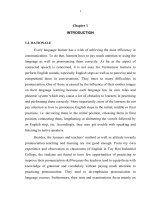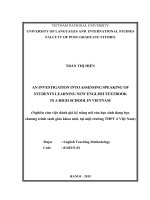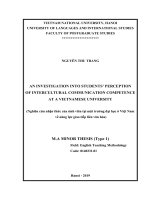An Investigation into the Implementation of a Brewpub at the New Student Union Building docx
Bạn đang xem bản rút gọn của tài liệu. Xem và tải ngay bản đầy đủ của tài liệu tại đây (312.48 KB, 23 trang )
i
UBC Social Ecological Environmental Development Studies (SEEDS) Student Report
An Investigation into the Implementation of a Brewpub at the New
Student Union Building
Samuel Chan
Nazanin Houshmand
Perry Yan
Tony Mao
APSC 262
March 28
th
, 2012
Disclaimer: “UBC SEEDS provides students with the opportunity to share the findings of their studies, as well as
their opinions, conclusions and recommendations with the UBC community. The reader should bear in mind that
this is a student project/report and is not an official document of UBC. Furthermore readers should bear in mind
that these reports may not reflect the current status of activities at UBC. We urge you to contact the research
persons mentioned in a report or the SEEDS Coordinator about the current status of the subject matter of a
project/report”
ii
An Investigation into the Implementation of a Brewpub at the New
Student Union Building
To: Dr. Carla Paterson and UBC Stakeholders
By: Samuel Chan, Nazanin Houshmand, Perry Yan, Tony Mao
March 28
th
, 2012
iii
Abstract
The new AMS Student Union Building will include a brewpub operation that aims to be
environmentally sustainable, economically feasible and socially acceptable in the context of the
UBC campus. This paper performs a triple-bottom line assessment looking at possible options in
achieving all three goals.
In regards to environmental sustainability, this paper presents three major negative
environmental impacts in the brewing process: wastewater output, waste grain byproducts and
energy consumption. The paper looks at possible solutions in the treatment of wastewater,
processes and partnerships to recycle the brewpub’s waste grain and possible resolutions to the
problem of energy consumption.
Assessment of the brewpub’s economic feasibility falls into two categories: assessment of the
brewpub’s operating cost and projection of the brewpub’s likely operating revenue. In the
assessment of the brewpub’s operating cost the paper discusses the cost of: initial equipment
investment, periodic ingredient purchases, heat and power costs and employee salaries.
Assessment of the brewpub’s operating revenue includes: pricing of beer and a brief break-even
analysis.
This paper assesses the brewpub’s possible social impact by discussing the health and safety in
regards to alcohol consumption, the community benefits in having an on-campus brewpub and
opportunities for on-campus learning.
Based on this paper’s research the following recommendations arise:
1. A GEA Westfalia Separator should be used for the treatment of the brewpub’s
wastewater as it offers incredible reductions in energy use and greenhouse gas emissions.
iv
2. Waste grain byproducts of the brewing process can be fed to animals and/or used as
fertilizer in the UBC Farm. The byproducts can also be used in the biofuel production
process, perhaps working in conjunction with the UBC Biofuel initiative.
3. The brewpub could use biofuel to fuel the stoves heating the mash in the brewing
process. Biofuels, in addition to being sustainable, also produces CO
2
offset of up to 85%.
4. The brewpub operating cost (given the proposed scope and objectives) will be: $200,000
initial investment for the brewing equipment, $14,000 annually in ingredients, $2,500
annually in energy and $375,000 annually in employee salaries.
5. The brewpub operating revenue will be $466,200 annually. The brewpub will profit after
the third year with a projected 10 year net profit of $540,600.
6. By using organic ingredients in conjunction with a controlled drinking environment the
brewpub could promote health and safety in the student community.
7. The brewpub could promote seasonal beers and events to relieve students of stress and in
general endorse student wellness.
8. The brewpub could open its doors to students in Applied Biology and/or Chemical
Engineering providing students with experience and information in working in a
professional brewing environment.
v
Table of Contents
Abstract iii
List of Tables and Figures vi
Glossary vi
Brewpub 1
1.0 Introduction 1
2.0 Environmental Assessment 2
2.1 Wastewater 2
2.2 Waste Grain 3
2.3 Energy Consumption 4
3.0 Economic Assessment 5
3.1 Brewpub Operating Expenses 5
3.2 Brewpub Operating Revenue 7
4.0 Social Assessment 9
4.1 Health and Safety 9
4.2 On campus social center 10
4.3 Opportunities for on-campus learning 10
5.0 Conclusion and Recommendations 11
References 13
Appendix 16
1.0 Survey Results 16
vi
List of Tables and Figures
Table 1: Tabulated Expense and Revenue of Brewpub Operations (pp.8)
Figure 1: Wastewater Treatment in Breweries (pp.2)
Glossary
Bbl – US beer barrel unit of measurement. Equals 36 imperial gallons, or 43 US gallons
or 164 litres.
AMSS – Alma Mater Student Society. The active student representive association at
UBC.
SUB – Student Union Building
Hops – A family of herbs commonly used as an ingredient the brewing process. Imparts a
bitter flavor.
Malt – Germinated grains by soaking in water to initiate the germination and quickly
drying out the grains to stop the germination. Another common ingredient used in the
brewing process. Imparts a sweet flavor.
kWh – Stands for kilo-watt-hours. A unit of power consumption
GJ – Stands for giga-joules. A unit of energy
Draft beer – Beer served straight from the keg (also known as Draught or Tap beer).
Ethanol – the type of alcohol typically found in alcoholic beverages.
Decanters – vessel used in the decantation (that is separation of mixtures) of sediments
(usually unwanted) from a liquid.
Separator – vessel used to filter out the unwanted sediments from the decanters.
Mashing – part of the brewing process where the malt is, as the word implies, mashed up
to an almost paste-like consistency.
Fermentors – tanks used in the brewing process to hold the malt during the fermentation
process where the alcohol in the beer is produced.
Wort – Liquid extracted from the mash during the boiling and lautering process.
Lautering – The process where the wort is separated from the grains.
1
Brewpub
1.0 Introduction
A brewpub is simply a pub where the beer it sells is brewed on site. Doing so ensures
freshness of the beer, control of quality and freedom in creativity on what types of beer to brew.
Brewpubs are often also restaurants and sometimes may even offer accommodations (kind of
like a motel).
As the most of the brewing process is done entirely on site, brewpubs are often much larger than
standard pubs to house all the extra equipment and facilities required for brewing. The brewing
process at brewpubs usually starts at the mashing stage where malted grains are grinded down to
a paste-like consistency. After lautering and boiling the mash, the young beer is conditioned and
filtered until it is ready for serving.
As a brewpub makes its beer, many environmental concerns can arise. Waste water, waste grain
and the energy consumption required to fuel the boilers and coolers are all environmental
concerns that need to be dealt with. Furthermore, brewpubs typically cost more to start and run
than a standard pub as a brew master needs to be hired to oversee the entire brewing process and
brewing equipment need to be purchased. A brewpub also offers many benefits to its community,
offering insight into the brewing process as well as opportunities for fun and exciting events that
may not be as tangible in a standard pub.
In this paper we discuss all the problems brewpubs face in terms of environmental impact, social
opportunities (and problems), and economic feasibility. We then offer the solution we best think
suits the objectives and needs of the new Student Union Building (SUB).
2
2.0 Environmental Assessment
The three aspects of the environment assessment of the brewpub that will be discussed
are wastewater, waste grain, and energy in the refrigeration and chilling process.
2.1 Wastewater
Wastewater is a major waste product of brewing. Approximately three to ten liters of
waste matter is produced for a liter of beer in breweries [1]. Wastewater may contain dangerous
chemicals that can affect the environment negatively as well as having a negative impact on
people’s health. There are several chemicals found in wastewater, mainly produced during the
fermentation process. These chemicals include: dissolved CO2, ten percent (by volume) of
ethanol, and a fraction of volatile acids. Consequently, the waste water must be carefully treated
in brewpubs. The figure below shows how wastewater is treated normally in breweries:
Figure 1: Wastewater Treatment in Breweries
Waste water is generated from remaining substances from production of beer as well as during
the fermentation process and cleaning of storage tanks.
Typically, a technology system known as the GEA Westfalia Separator is mostly used for waste
water treatment (GEA, 2012). It consists of decanters and separators operating continuously that
3
are efficient in clarification and separation, and is also energy efficient (GEA, 2012). Decanters
are also efficient for removing the residues, solid wastes, and the cleaning agents of storage
tanks. This affects the environment positively as well as reducing disposal costs.
Another alternative for wastewater treatment is to transport the waste water to the Iona Island
Sewage Treatment facility via the Greater Vancouver Regional District (GVRD) sewer (Grant
and Hill, 2002). The wastewater at the facility center is treated by removing 90 percent of
biological oxygen demand (BOD) before the remaining water is released into the Fraser River
(Metro Vancouver, 2011). This method would be easily integrated, as this is also how
wastewater produced on other parts of the campus are treated by transporting to the facility
center. However, as the GEA Westfalia Separator process has such huge benefits in emissions
and energy efficiency, we recommend the GEA for treatment of the UBC brewpub’s wastewater.
2.2 Waste Grain
During the process of brewing, there will always be around 92 percent of brewing
ingredients wasted (America Brewer, 2007). One of our primary sources on waste grain was
going to the SteamWorks Brewing Company, a brewpub located at Waterfront. At SteamWorks,
we asked how they dealt with waste grains, and found out that waste grains can be used for plant
fertilizers and animal feed.
In fact, waste grains have a lot of protein and fiber and actually work really well as healthy
animal feed as well as being an effective fertilizer (America Brewer, 2007). Specifically, waste
grains can be fed to pigs, goats, fish and cattle (America Brewer, 2007). This provides an
interesting opportunity to partner with the UBC Farm. The UBC Farm could provide the
brewpub with seasonal hops, grains, fruit and other ingredients in making all types of beer. The
brewpub in turn supplies them with waste grains for use as fertilizer.
Furthermore, waste grains can be used in the production of ethanol, which is a main reagent in
the production of various biofuels (America Brewery, 2007). In summary, all of those
alternatives not only prove waste grains are environmentally-friendly but also resourceful by-
products. We recommend that the brewpub in the new SUB form a partnership with the UBC
4
Farm to use the waste grain in a sustainable manner.
2.3 Energy Consumption
Energy consumption is another important issue to consider for breweries. There are a
couple of different energy requirements in brewing especially during the initial production of the
wort (Butler, 2012). To create the wort, the water first has to be heated 65 degrees Celsius before
adding the malt for mashing. The water then has to be boiled for about 1.5 hours which will boil
off about one-quarter of the water. The amount of energy required including heat losses to the
environment depends on the beer production capacity (Butler, 2012). For a 10 bbl brewing load,
about 14 gigajoules (GJ) of heat energy will be consumed.
As well as for heat, the pumping energy is needed to move the fluid around the brewery. This
depends on how much fluid has to be moved and how fast as well as taking into consideration
the size of pipes and lines, and the number of fittings, valves, and filters for the fluid to be
pumped through (Butler, 2012).
Also, more energy is needed for cooling the fermenters since yeast produces heat during
fermentation. Consequently, the heat has to be removed to keep the beer cool; otherwise, a hot
fermentation will cause the beer to spoil. Usually, beer yeasts ferment around 20 degrees Celsius.
There are a few recommendations for UBC brewpub to manage energy consumption. As the
UBC central steam network is being converted to hot water, the other choice would be natural
gas. Moreover, biodiesel would be a good alternative to natural gas or oil for heating the mash.
In fact, National Energy Technology Laboratory (NETL) recently did a study of the CO
2
offset
of using biodiesel (Butler, 2012). We recommend the brewpub to use biodiesel from waste
vegetable oil for the majority of the brewpub’s energy needs as the CO
2
emissions is 85 percent
less in comparison to regular diesel.
5
3.0 Economic Assessment
The economic assessment of the triple bottom line of the UBC New Sub brewpub project
is an operating income analysis of the brewpub. The key goal for this brewpub is to exclusively
serve its own beer in the pub, as it costs less for the student body, while also costing less for the
UBC AMSS in the long run. The brewpub operating income can be decomposed into expenses
and revenue. The expenses and revenue calculations of the UBC New Sub brewpub operation is
modeled around 1000 bbl (US barrels) per year. We suggest 1000 bbl/year of brewing volume
as it is equivalent to 20 bbl/week.
3.1 Brewpub Operating Expenses
The operating expenses can be broken down to the following: equipment investment, raw
ingredient purchases, combined heat and power costs, and employee salaries. Refer to Table 1
for tabulated expenses and revenue.
3.1.1 Equipment Investment
The largest investment required for a brewpub startup is the purchase of brewing
equipment. The following equipment is needed for brewing: malt miller, mash tun, brew
kettle/whirlpool, frame heat exchanger, process control system, hot liquor tank, storage tanks,
refrigeration system, and accessories such as tubing, valves, and consumable filters (Green,
2011).
It is suggested that a brewing capacity of 10 bbl will be used, as it is realistic to brew two large
batches of beer in a week in order to meet the 1000 bbl/year margin. The average Canadian
student (aged 19-30) consumes 2.1 pints of beer per sitting (Garriguet, 2008) – meaning that 20
bbl per week can serve at least 343 people per day, or 2400 people per week.
We feel that this amount of beer production is sufficient to meet the demand of the current UBC
Pit Pub. Upwards of CAD$200,000 will be invested in brewing equipment (Green, 2011). A
typical brewing system will have a manufacturer rated life time of 10 years (FLECKS Brauhaus
Technik GmbH, n.d.) before maintenance is required, however maintenance will be done year-
round.
6
3.1.2 Raw Ingredient Purchases
The main raw ingredients of beer are malting barley, hops, yeast, and water. Two key
objectives of the brewpub will be to source raw ingredients from local farms in order to reduce
use of vehicular transportation, and to encourage students to learn about the UBC farm and other
local farms.
Two local (in the Lower Mainland region) ingredient sources include the UBC Farm and the
Delta Farmland & Wildlife Trust. In addition, the Yakima Valley in Washington is a potential
ingredient source.
The average wholesale cost of malting barley and hops are $320/tonne (Agriculture and Agri-
Food Canada, 2011) and $9921/tonne respectively (Kneed, n.d.). An average of 24 tonnes of
malting barley and an average of 0.65 tonnes of hops are used to produce 1000 bbl of beer per
year (Sound Brewing Systems, Inc., n.d.). A sample of yeast can be re-used over 100 times (Van
Zandycke, 2010).
The cost of brewing yeast is negligible; we suggest that yeast should be home-grown instead of
being purchased. The ratio of volume of water usage to beer volume is about 3.3 to 1 (Sound
Brewing Systems, Inc., n.d.)
3.1.3 Heat and Power Costs
A major goal of the brewpub is to operate with high energy efficiency for the brewing
processes. As UBC is one of the leaders of sustainability in the world, having a brewpub as an
energy-efficiency test bed will be beneficial to UBC’s green status.
For example, recently researched methods of waste heat recycling from waste effluent
condensate may be utilized in the brewpub to increase heat usage efficiency (Muster-Slawitsch et
al., 2011), and as a result, lower the combined heat and power (CHP) costs of brewpub
operation.
The main heating costs are attributed to the mashing and boiling processes (“Brewing”, 2012).
An average brewpub producing 1000 bbl/year consumes about 10,000 to 15,000 kWh of
7
electrical power per year, and about 140 GJ of natural gas heat per year (Sound Brewing
Systems, Inc., n.d.). Assuming an electrical power cost rate of $0.09 per kWh (BC Hydro, n.d.)
and a natural gas cost rate of $4.00 per GJ (FortisBC, n.d.), a conservative estimate for total costs
will be $1910 annually.
3.1.4 Employee Salaries
The head employee of a brewpub is the brew master. A typical brew master in Canada
will make $75,000 to $100,000 annually, and brewing assistants make $40,000 to $50,000
annually (SimplyHired, n.d.). In addition to the brewing staff, there should be a pub staff (cooks,
waiters, security) count of 15-20. For an estimate salary of the pub staff, we used an average
annual salary of $15,000 per person.
3.2 Brewpub Operating Revenue
The operating revenue is solely dependent on draft beer sold in the pub. Our goal is to
exclusively sell the beer brewed in-house in the brewpub.
3.2.1 Beer Pricing
According to a survey done with students in the UBC sub (sample size of 49), the
average amount that a student would pay for a pint of beer would be $3.70. We recommend that
the sales price deviate around this price (before sales tax). Assuming that the brewpub sells 50%
of its maximum beer volume (500 bbl /year out of a possible 1000 bbl/year) at this price, the
revenue will be $466,200.
3.2.2 Break Even Analysis
According to AMS Finance VP, Elin Tayyar, the break-even goal, including
infrastructure expenses, is 20 years (as cited in Mann, 2011). For our analytical model, we did
not take the infrastructure expense into account as it is an unspecified amount out of the UBC
New Sub $100 million budget.
Referring to Table 1, given an annual net profit of $74,060, it takes about two years after the first
year to make a profit.
8
Initial
Cost
Annual
Cost
Annual
Revenue
Brewing Equipment
$200,000
$0
$0
Liquor License [12]
$550
$1,100
$0
Raw ingredients
*Malt Barley
$0
$7,680
$0
*Hops
$0
$6,450
$0
Energy
*Electricity
$0
$1,350
$0
*Heat
$0
$560
$0
Employee Salary
*Brew Master
$0
$100,000
$0
*Brew Assistant
$0
$50,000
$0
*Pub Staff
$0
$225,000
$0
Cooks, Waiters, Security (Count = 15)
Revenue @ Pub
$0
$0
$466,200
*Assuming selling 500 barrels/year
Annual Net Profit
$74,060
First Year Net Profit
-$126,490
10 Year Net Profit
$540,600
Table 1: Tabulated Expenses and Revenue of Brew Pub Operations
9
4.0 Social Assessment
UBC campus has had a few social drinking places for its students for many years. Two of
which, The Pit and The Gallery, are located at the current SUB. The Pit is famous for its Pit
Night Wednesdays, and The Gallery for Toonie Tuesdays ($2 beers on Tuesday nights). Even
though, both places have been a tradition for many years. After surveying students (count 49),
most agreed that having a brewpub is a great idea, as long it is named “The Pit” and the average
price is no higher than $4 per sleeve of beer. In addition, the survey indicates the misinformed
nature of UBC’s student body in regards to the current pubs, which can easily be solved using
different marketing strategies. An example of a good marketing strategy is using social
networking websites to promote events at brewpub (Houshmand & Chan, 2012).
4.1 Health and Safety
Since the function of the new brewpub is to serve the local, the students of UBC are the
ones mostly affected by it. Every day, students undergo a great amount of stress resulting from
tests, assignments and projects; what better way to release stress than having a drink?
Study shows, beer is in fact a great stress reliever and having a beer per day could decrease the
possibility of having coronary heart disease by 30% and of having a stroke by 20%. However it
should be drank in moderation or it could have reciprocal effect (Friedman & Klatsky, 1993).
One option to ensure that students do not abuse their alcohol consumption is to have a limit to
the amount that one can intake during the day. For example, the University and/or the brewpub
could have a standard limit on the hourly consumption of alcohol for each patron that will
subsequently be enforced by the staff.
Since the students of today are the future of tomorrow, the well-being of the beer provided by the
brewpub must be assured; the brewpub is the first step towards a healthier drink. The advantage
of home-brewing beer over the manufactured kind is ingredient control. The AMS would have
the full power over the ingredients and flavors for each beer. For example, replacing chemically
artificial products with organic kind, imported from UBC’s own farm results in a more nutritious
drink. The UBC farm has offered to provide the pub with 10lbs per each of their seven different
10
varieties of hops. In addition, the farm can have strawberries and blueberries available for
seasonal beers (Bell, 2012).
4.2 On campus social center
Every year, different coffee shops such as Starbucks have seasonal drinks. Can there be a
seasonal brewed beer? A close visit of a famous brewpub, SteamWorks at Waterfront, answers
the question. Every season SteamWorks regulars get excited about the brewpub’s season
appropriate flavored beers; having a similar concept of seasonal beer implemented in to the
brewpub is an easy way to have the students cheering for the upcoming season and it is also a
clever marketing strategy. In addition, having special drinks such as coffee flavoured beer during
exam period provides the caffeine needed for the late night studies.
4.3 Opportunities for on-campus learning
The brewpub also provides a great facility for students of Applied Biology and/or
Chemical Engineering for brewing research. A brewpub would have all the facilities and
machines of a larger conventional brewery and offers a learning opportunity matched only by
actual commercial breweries and/or microbreweries. Students may even be offered opportunities
to try out their own technologies and brewing recipes using the brewpub facilities. For example,
a graduate student in Applied Biology researching brewery wastewater treatment would have
access to data regarding wastewater output of a typical brewpub. He/she could also run tests of
his/her thesis on this output (i.e. a microbiology filtering system that recycles the water). The
learning possibilities with the brewpub are endless (Honeybourn, 1994).
11
5.0 Conclusion and Recommendations
A brewpub in the new Student Union Building would make UBC the first Canadian
University to have an on-campus brewpub. A brewpub would bring about a lot of benefits as
well as lots of potential problems that a normal pub wouldn’t bring to light. The
recommendations in this paper aim to take advantage of the benefits while minimizing the
problems all in the context of a brewpub by UBC for UBC.
In our environmental assessment, we recommend UBC use the GEA Westfalia Separator to treat
the wastewater output from the brewpub due to its reduction in greenhouse gas emissions as well
as its excellent energy efficiency. We recommend the brewpub work in partnership with the
UBC Farm to establish a cycle where waste grains shipped to the Farm for use as fertilizer while
the Farm provides the brewpub with seasonal herbs, grains and fruit for use in seasonal beers.
Lastly, we propose the use of biofuels, possibly created from some of the waste grains itself, to
power many of the heating and cooling facilities in the brewpub as it minimizes the pub’s CO
2
footprint in comparison to using conventional fossil fuels.
Our economic assessment had us analyzing the total annual cost for operating an on campus
brewpub and the projected year-to-year revenue and profit of the establishment. Our numbers has
us recommending we keep the brewpub to 1000 bbl/year output, equivalent to serving over 300
students per week. We propose to hire a brew master and at least one assistant at salaries of
$100,000 and $50,000 respectively. Furthermore, we recommend the brewpub not spend more
than $200,000 on the brewery equipment. The size of the brewpub can be than shrunk/expanded
based on the recommended serving capacity and would likely be between 5000 to 10000 ft
2
.
Lastly, our social assessment concludes with recommendations towards promoting student health
and safety, providing a relaxing atmosphere and providing learning opportunities for campus
students. We recommend the promotion of health and safety in the new brewpub by affixing a
firm drink limit as well as using organic ingredients in the brewing of the beer. We also
recommend the organization of seasonal events and/or menu items to encourage student life
wellness. Lastly, we recommend the AMS to form partnerships with the department of Applied
12
Biology and Chemical Engineering to provide students in those faculties with first-hand
experience in testing and learning about the commercial beer brewing process.
13
References
Agriculture and Agri-Food Canada. (2011). The Canadian Brewery Industry. Retrieved from
American Brewer. (Spring 2007). Grains of Possibility. Ways to Use Spent Brewing Grains.
Retrieved from />spent-brewing-grains/
APEX Publishers. (2011). Wastewater and Solid Waste Management. Retrieved from
/>brewing/wastewater_solid_waste_management/brewery_wastewater.htm
BC Hydro. (n.d.). SGS Bill Explainer. Retrieved from
BC Ministry of Justice: Liquor Control and Licensing Branch. (2011). Licence Fee Schedule
(LCLB010). Retrieved from
Bell, S. (2012, February 20). Interview by F. Liu [Personal Interview]. UBC farm collaboration
with brewpub. Unpublished.
Brewing. (n.d.). In Wikipedia. Retrieved March 22, 2012, from
Butler, James. (2012, March 22). Email Interview.
Coulter, M. (1987). The step-by-step approach to planning, building and running a small
brewery is the only way to fly. Retrieved from
14
FLECKS Brauhaus Technik GmbH. (n.d.). Pub Brewery Technology : Brewing Vessel : Pub
Brewery Equipment : Brauhaus-Austria.com. Retrieved from uhaus-
austria.com/technique.htm
FortisBC. (n.d.). Lower Mainland – Rate 2. Retrieved from
/>px
Friedman, G. D., & Klatsky, A. L. (1993). Is alcohol good for your health? The new england
journal of medicine, (329), 1882-1883. Retrieved from
Garriguet, D. (2008). Beverage consumption of Canadian adults (Report No. 82-003-X).
Retrieved from Statistics Canada Health Reports: />x/2008004/article/6500821-eng.pdf
GEA Westfalia Separator Group. (2012). Treatment of Brewery Waste Water. Retrieved from
/>waste-water.html
Grant M., Hill G., Holbrook, C., Lymburner P, McTavish A., Sundby A. (2002). “Water
Management and Waste Water Treatment at the University of British Columbia: A Study
for Sustainable Alternatives.” The Univeristy of British Columbia, Vancouver, CAN,
2002
Green, R. (2011, August 12). SYWTOABP 7: How much does commercial brewing equipment
cost? Retrieved from />does-commercial-brewing-equipment-cost/
Hieronymus, S. (1999). Brewpubs and distribution. Retrieved from
Honeybourn, J. (1994). Bachelor of Science-Applied Biology. Retrieved from
15
Houshmand, N. & Chan, S. (2012, March 9). Response of 49 students at the SUB regarding the
new brewpub substituting The Pit and The Gallery. Unpublished.
Kneed, R. (n.d.). Small scale and organic hops production. Retrieved from
Mann, A. (2011, March 2). AMS looking to install brewpub in new SUB. The Ubyssey.
Retrieved from
Metro Vancouver. (2011). Wastewater Treatment. Retrieved from
Muster-Slawitsch, B., Weiss, W., Schnitzer, H., & Brunner, C. (2011). The green brewery
concept - energy efficiency and the use of renewable energy sources in breweries.
Applied Thermal Engineering, 31, 2123-2134. doi:10.1016/j.applthermaleng.2011.03.033
SimplyHired. (n.d.). Brew Master Salaries. Retrieved from
Sound Brewing Systems, Inc. (n.d.). Industry Info, Standards, Statistics, and Conversion
Factors. Retrieved from
Van Zandycke, S. (2010). Probrewer: Yeast in brewing. Retrieved from
16
Appendix
1.0 Survey Results
How much
would you
spend on beer?
How often do
you go to
pit/gallery?
How do you feel
about the
possibility of
them closing for
a new brewpub?
Other
comments
4
b
b
4.5
c
a (food?)
3
d
a (food?)
3.5
d
b
4
c
b
3.5
b
a (food?)
keep pit night
3.5
c
b
two different
locations would
alleviate crowds
4
never
b
4
d
b
3
d
a (food?)
5
c
b
3
d
d
3
b
d
wants pit to stay
+ new brewpub
6
c
b
4
c
c
i don't particularly
care
3.5
c
b
4
c
c
4
c
b
3
b
a (food?)
2.5
c
c
3.5
c
b
cool
4
d
b
4
b(gallery more)
d
3
b
d
0
c
c
5.25
b
d
Allow meal plan
to pay for beer!
Loves pit night
3.75
b
a (food?)
3
c
c
Excited
4.5
c
b
4
c
a (food?)
3
d
c
5.5
d
a (food?)
17
4
c
a (food?)
Wants 2; both
gallery and pit
3
c
c
4
c
c
Average price of
beer
3.70
Column 2:
a=more than
once a week;
b=once a week;
c=once per
month; d=where?
Percentage
a
0
0
b
7
0.205882353
c
18
0.529411765
d
8
0.235294118
Column 3:
a =i love it; b=i
don't care; c=not
a big fan; d=i
hate it
Percentage
a (food?)
9
0.264705882
b
13
0.382352941
c
8
0.235294118
d
5
0.147058824
Sample Size = 34









